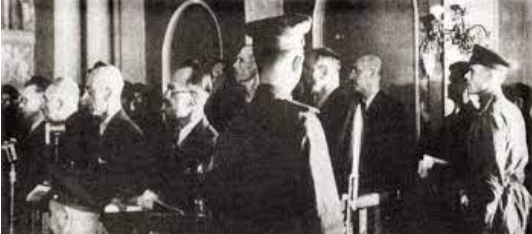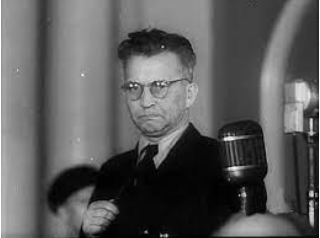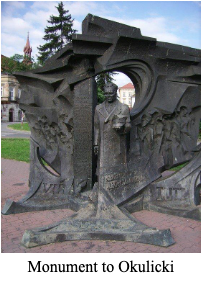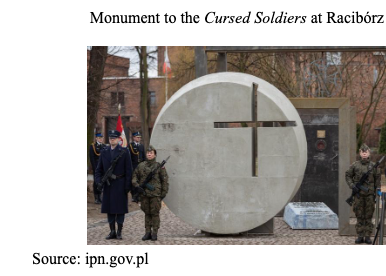Trial of the Sixteen
Proces szesnastu
 Source: NK
Source: NK
Introduction
The arrest of senior leaders on 27th to 28th March 1945 silenced the ‘Polish Question’ while the country fought a civil war until 1947 as the ‘closing curtain’ to the conflict with the Allies giving muted consent that the Lublin Committee represented ‘national unity’ (Zurowski, 1989). Indeed, the failure of the Polish Government in Exile to develop direct diplomatic relations rather than going through Britain’s Foreign Office, enabled the Soviets ‘free rein’ to impose a communist backed government without much opposition (Prazmowska, 2004; Perkowski and Waszkiewicz, 2022). Roosevelt’s opinion that the Polish Government in Exile’s unrealistic desire to reimpose the 2nd Republic’s border to pre-war boundaries (Beevor, 2002; Sebestyen, 2014) would not be supported by the Allies. From the comfort of their Whitehall and parliamentary offices, or the White House and Capitol Hill, the Soviet show trial demonstrated the extent ‘Sovietisation’ or terror that would come in the following decades (Paczkowski, 1995) an enduring hardship for Poland until democracy would be reinstated.
The hard ‘truth’ was that both the British and American public were war weary and lost their ‘appetite’ for conflict, and the collapse of European political, social, and economic systems made many nations and ‘displaced persons’ (DP’s) close to starvation despite the efforts of the UNRAA to feed over 4 million refugees including the DPs (Sebestyen, 2014). Likewise, in Poland the desire to see the end of hostilities and economic reconstruction saw the public turn their backs on the lawlessness associated with the underground struggle which offered little to them (Prazmowska, 2004) other than on-going suffering and hardship. The civil war through various splinter groups against the Soviets and UB created the ‘cursed soldiers’ (żołnierze wyklęci) whose political legacy is active today (Końzal, 2019)
Although Stanisław Mikołajczyk had returned to Poland a hero, pressure from Stalin, Churchill, and Roosevelt over recognition of the Curzon Line and Soviet influence in Polish affairs, effectively compromised his political standing (Williamson, 2012). The demand for the restitution of the 1921 constitution gave the communists an opportunity to exploit the ensuing political vacuum (Paczkowski, 1995; Prazmowska, 2004) through arrests and subverting legitimate parties. Despite his efforts in the 1947 elections and his recognition of the Yalta Agreement in order to join the Provisional Government, the repositioning of political parties, the collapse of the Peasant Party and emergence of the more cohesive Labour Party undermined attempts to revert to the pre-war constitution (Paczkowski, 1995). He subsequently went into hiding when the threat in loss of parliamentary immunity and immanent death were made known to him ironically through Bolesław Drobner, a communist and leader of the PKWN or ‘Lublin Poles’ whose support for the communists began to waver (Paczkowski, 1995).
The show trial of the leaders of the Polish Underground State (Polskie Państwo Podziemne) in Moscow was ‘staged’ with dubious charges levelled at the Sixteen in a move to break any opposition and bury the notion of democracy. This trial differed from the Supreme National Tribunal which sat from 1946 until 1948 that focussed on the Nazi’s responsible for war crimes, as the Polish (Soviet) version of the Nuremberg Trials (Karski, 2022); the Minsk war crimes trial of 1946 based on Soviet jurisprudence (Ziedler, 2004, Williamson, 2012) or the displaced Poles (civilians) from eastern provinces by Soviet military courts (NKVD) to stifle and destroy any opposition, real or imagined, to communism at the request of the communists. These trials lasted from 1946 until 1955 (Lityński, 2016) and were a ‘smoke screen’ to deflect attention away from NKVD atrocities in Poland (TNA HS4/ 319) and the murderous operations like AUGUSTÓW MANHUNT (Little Katyń Massacre) which saw 40,000 communist troops suppressing former AK units in the eastern provinces where 600 were killed and thousands arrested (Prazmowska, 2004; Perkowski and Waszkiewicz, 2022).
The Government Delegate, Jan Jankowski (Delegatura, the de facto Deputy Prime Minister), leading members of the Council of National Unity (Rada Jedności Narodowej) and the ex-Commander in Chief of the AK (Armia Krajowa) Leopold Okulicki, were invited to a ‘conference’ by Soviet Colonels Pimienov and Ivanov who was in reality General Serov (head of Polish Ministry of Public Security) on 27th – 28th March 1945 to meet the representatives of the First Belorussian Front at Pruszków, S.S.W of Warsaw (Paczkowski, 1995; Prazmowska, 2004; Kochanski, 2012). The ‘guests’ safety was guaranteed by the Soviets within the invitation letter (Bałk, 1995). General Ivanov had been instrumental in the deportation of Poles from the eastern provinces and directed the Katyń Massacre (Bałk, 1995) at the outbreak of the war.
Jankowski and Okulicki were accompanied by three of Jankowski’s deputies: Bień, Pajdak and Jasiukowicz who was chairman of the Council of National Unity (Prazmowska, 2004; Kochanski, 2012). The group also consisted of council members: Kazimierz Bagiński, Eugeniusz Czarnowski, Stanisłsaw Mierzwa, Franciszek Urbański, Józef Chachiński, Kazimierz Kobylański, Stanisłsaw Michałowski and Zbigniew Stypułkowski and flown to Moscow where they were joined by Aleksander Zwierzyński who was already imprisoned there in the Lubyanka and had been tortured (Kochanski, 2012). The Soviets remained silent over the arrest of the Sixteen. Edward Raczyński, the President of the Government-in Exile, petitioned Anthony Eden, and US Secretary of State Edward Stettinius Jr. to raise the arrests with Molotov during the San Francisco conference at the end of April 1945. It was not until 3rd May; Molotov acknowledge the arrests after Eden and Stettinius again demanded an explanation from the Soviets (Prazmowska, 2004; Kochanski, 2012).
Okulicki had disbanded the AK on 19th January 1945 and began to form NIE and its later successor WiN (Wolność i Niezawiłść) which to all intents and purposes reflected the core political stance of the AK (Prazmowska, 2004; Williamson, 2012) which united some, but not all former underground army groups. They were still fighting an isolated civil war in the eastern provinces against the NKVD and their pogrom of ethnic cleansing particularly in the battle of Kuryłówka on 6th to 7th May 1945 where the National Military Union (NSW) defeated the Soviet 2nd Border Regiment of the NKVD that resulted in retaliatory actions against local villages. Link: Vistula
The Trial
The trial took place between 18th to 21st June 1945 inside the Lubyanka with the foreign press and observers from Britain and the USA attending. The trial unsettled the Polish diaspora and troops on occupation duties in Europe, notably in Germany and northern Italy. The Sixteen were accused of crimes that were crude and politically inept and yet raised little opposition from any of the Allies. The post war confusion covering the whole of Europe and the need to rebuild countries became a focal point so much so that Britain and the USA broke off discussions over the future of Poland’s composition of its future government (Davies, 2003). How effective this stance was, is still contested, however the charges could have been substantially challenged both in the detail and under the 1907 Hague Convention IV. It was not until the collapse of communism in Poland and later the USSR that the details of the interrogations and torture, particularly of Okulicki emerged (Davies, 2003). Ironically, Okulicki clearly indicated his willingness to co-operate with the Soviets as there was no alternative or political leeway according to the transcripts.
The broad charges were:
- Collaboration with the Nazis
- Intelligence gathering and sabotage at the rear of the Soviet Army
- State terrorism
- Planning a military alliance with the Nazis
- Owning radio transmitters, printing machines and weapons for use against the Soviets
- Propaganda against the Soviet Union
- Membership in banned underground organisations (against the Soviets)

Source: NK
Okulicki was further accused of preparing diversionary activities in the rear of the Soviet Army (Kochanski, 2012) while the rest of the ‘accused’ were charged with installing and maintaining illegal radio transmitters in the rear of the Soviet Army. All were coerced to plead guilty through torture.
The verdict was issued on 21st June 1945 in typical Soviet show-trial style by Lt. Gen. Vasil Ulrikh who was an experienced presiding judge from the ‘Great Purge Trials’ (Great Terror) during 1936 to 1938 ordered by Stalin. The verdicts received a muted response from the British and Americans (Davies, 2003; Koskodan, 2009) to the dismay of the government in exile.
Okulicki was sentenced to 10 years in prison. He well understood what the sentence would bring as he’d been tortured and had already experienced the Lubyanka at the hands of the NKVD when Poland was partitioned by the Nazis and the Soviets in 1939. He was murdered on 24th December 1946 (Bałk, 1995) having been a loyal and distinguished career officer intent to secure a fair and democratic future for Poland. Jan Jankowski was sentenced to 8 years and died while in captivity on 13th March 1953 just before he was due to be released.
Adam Bień and Stanisłsaw Jasiukowicz each faced 5 years. Bień returned to Poland and eventually resumed his legal practice in Przasnysz in 1953 under observation and surveillance from the UB. Jasiukowicz died while imprisoned in the Soviet Butyrka prison near Moscow.
Stanisłsaw Jasiukowicz was sentenced to 1.5 years and returned to Poland where he was hounded by the UB/SB and re-arrested in 1947. Sentenced to another 10 years, he died in prison on 30th April 1950. Aleksander Zwierzyński was sentenced to 8 months and returned to Poland and excluded from participating in politics.
Kazimierz Bagiński was sentenced to 1 year but released after two months under an amnesty and joined Mikołajczyk’s Polish People’s Party before being re-arrested in 1946 and sentenced to a further 10 years in prison. In 1947 an amnesty through President Bierut, enabled him to escape over the ‘green border’ (the division between the occupation forces and Soviets) and settled in the USA as a political activist. Eugeniusz Czarnowski was sentenced to 6 months and returned to Poland where he emersed himself in politics and in 1946 became a member of the Supreme Council and the Central Democratic Party.
Józef Chachiński, a survivor of Auschwitz-Birkenau, was sentenced to 4 months and returned to Poland. Stanisłsaw Mierzwa and Zbigniew Stypułkowski were also sentenced to 4 months. On his release, Mierzwa joined WiN and active in the Polish People’s Party. Arrested again, the tribunal sentenced him on 10th September 1947 to a further 10 years in prison and released in 1953 to resume his legal practice between 1956 to 1975 in Kraków. Stypułkowski on his release was subject to UB> scrutiny and escaped over the ‘green border’ and given protection with the Polish 1st Armoured Brigade on occupation duties in Germany who arranged for him to be transferred to the 2nd Corps in northern Italy before he was evacuated to Britain in 1946 where he devoted his time to family, the National Party in exile and authored several books on his experiences.
Franciszek Urbański also sentenced to 4 months and returned to Poland where he died on 7th December 1949.
Stanisłsaw Michałowski and Kazimierz Kobylański were both acquitted. Michałowski immediately returned to Poland and his home city of Poznań. He returned to politics and was re-arrested in July 1948 by the UB and in January 1950 sentenced to 9 years in prison. In June 1952, he was released under supervision of the UB. In 1955 he worked for the Provincial Geodetic Company of Municipal Economy in Poznań and found time to farm, give legal advice and social work until the formation of Solidarity. He wrote about his exploits in numerous publications and died in 1984. Kobylański returned to Poland and became active in the formation of the National Party where he was part of a group petitioning Bolesław Bierut to recognise the party and seek a truce with armed resistance still operating in numerous districts within Poland. The UB re-arrested him with other co-signatures in September 1945 and released shortly afterwards. He was again arrested in July 1947 and sentenced to 8 years in prison by a Military District Court and released in 1954.
Aftermath
The propaganda ‘fanfare’ surrounding the trial of the ‘Sixteen’ was one of a series of “own goals” by the Soviets. These trials tarnished the judiciary through its legality, the Soviet policy towards Poland and the politburo’s role in the whole affair. The show trials did little for the Soviets international reputation or even instil a sense of political worthiness of the Soviet regime in occupied countries that still resonates today. The lack of action or protest underlines Roosevelt’s stance on avoiding further conflict since Yalta had already been bypassed by the Soviets (Zurowski, 1989; Koskodan, 2009; Kochanski, 2012) leaving Britain and America in a political void and who were focused on rebuilding western Europe in light of ‘Cold War’ developments.
As the links between the government in exile and the AK diminished in 1944-45, the failure of the Warsaw Uprising and the Soviets ‘iron fist’ to crush any resistance, acted as a catalyst to former Polish political parties to fragment from the degree of cohesion the AK had experienced during war (Prażmowska, 2004). War weariness and several amnesties effectively destroyed resistance (Prażmowska, 2004) enabling a communist dictatorship to reign until Solidarność in the 1980s broke their grip on the political system.
The ‘ruse’ of introducing new political parties prior to the 1947 elections through using the exact names of non-communist parties, including the Peasant Party was a further attempt to legitimise the Lublin Committee (Koskodan, 2009). The de-stabilization effect caused confusion. The party led by Mikołajczyk was forced to change its name to the ‘Polish Peasant Party’ (PSL) to avoid confusion at the polls
The resistance by groups like WiN, the NSZ (Narodowe Siły Zbrojne) and the National Military Union (Narodowe Zjednoczenie Wojskowe) attacked military outposts, concentration camps and political detention centres well into the 1950s whose followers were killed or imprisoned, becoming the ‘cursed soldiers’. The Soviet terror imprisoned 300,000 between 1944 – 1956 with up to 20,000 murdered in camps with further ‘show trials’ such as Witold Pilecki’s continued to demonstrate the willingness of the communist government to crush any opposition. An amnesty in October 1956 saw 30,000 former AK soldiers released signifies the extent to which the communists needed to control any attempts at opposition.
Opposition to the communist regimes in the Soviet bloc would periodically flare-up: 1953, 1956, 1968 and 1980-1981 (Kramer, 2003). The decision by General Jaruzelski to suppress the Prague Spring in January 1968 through the invasion of Warsaw Pact forces, demonstrated the lengths he was prepared to suppress dissent and the rise of Solidarność bringing a greater crisis to the ‘Cold War’. It was not until communism in Poland became redundant that Solidarność would eventually give hope and eventually usher in a new era not only in Poland, but across former Soviet controlled states in central Europe and the Balkans (Kramer, 2003). The imposition of martial law in December 1981 where fuel and food shortages dominated everyday life which was supported by the brutal oppression by the security services (Paczkowski, 1995) further alienated the Poles. Martial law was surprisingly not supported by the Soviets despite Jaruzelski’s request to invade Poland (Paczkowski, 2015), leaving him increasingly isolated in the Soviet bloc and later perceived to be a traitor.
The ‘Cursed Soldiers’ were rehabilitated and rewarded their rightful place in Poland’s history in 2011 when the Polish Parliament officially recognised 1st March would be designated as a Remembrance Day of the execution of the seven officers of WiN.

Source: NK

Further Reading
Bałk, S.S. (1995) “Poles on the Fronts of World War II”, ARS, Warsaw, Poland.
Beevor, A. (202) “Berlin: The Downfall 1945”, Viking, UK.
Cienciala, A.M. (2001) “The Polish Government’s Policy on the Polish-Soviet Frontier in World War II as Viewed by American, British and Canadian Historians”, Polish Review, Vol.46, No. 1, pp. 3 – 26.
Davies, N. (2003) “Rising ’44: The Battle for Warsaw”, Macmillan, UK.
Kaminski, Ł. (ND) “1945 – The Polish Perspective January 1945: The “Liberation” of Warsaw”,Polish History, (https://polishhistory.pl/1945-the-polish-perspective/) (Accessed 22.02.2023)
Karski, K. (2022) “NAJWYŻSZY TRYBUNAŁ NARODOWY A OSĄDZENIESPRAWCÓW ZBRODNI POPEŁNIONYCH PODCZASTŁUMIENIA POWSTANIA WARSZAWSKIEGO –NIEWYKORZYSTANY INSTRUMENT”, Studia Iuridica, XCI, pp. 122 – 145.
Kochanski, H. (2012) “The Eagle Unbowed: Poland and the Poles in the Second World War”, Allan Lane, UK.
Końzal, K. (2019) “The Invention of the ‘Cursed Soldiers’ and Its Opponents: Post-war Partisan Struggle in Contemporary Poland”, East European Politics and Societies and Cultures”, Vol.34, No.1, pp. 67-95.
Koskodan, K.K. (2009) No Greater Ally: The Untold Story of Poland’s Forces in World War II,” Osprey Publishing, UK.
Kramer, M. (2003) “The Collapse of east European Communism and the Repercussions within the Soviet Union (Part 1)”, Journal of Cold War Studies, Vol.5, No.4, pp.178-256.
Lityński, A. (2016) “Military Courts for Civilians in Poland (1946)”, Studia Iuridica Lublinensia, No. 25, Vol. 3, pp. 523 – 541.
Nowak, J. (1982) “Courier from Warsaw”, Wayne State University Press, USA.
Paczkowski, A. (2003) “The Spring Will Be Ours: Poland and the Poles from Occupation to Freedom”, Pennsylvania State University, USA.
PPaczkowski, A. (2015) “Revolution and Counter-revolution in Poland, 1980 – 1989: Solidarity, Martial Law and the End of Communism in Europe”, Rochester Studies in East and Central Europe, Vol. 14, pp. 1- 404.
Perkowski, M and Waszkiewicz, A. (2022) “Victims of the “New Deal” – Polish Independence Underground in the years 1944–1963 in the light of the then international law” in Grzebyk, P and Wierczynska, K “The Communist Crimes. Individual and State Responsibility, Wydawnictwo Instytutu Wymiaru Sprawiedliwości, Poland, pp. 163 – 178.
Prażmowska, A.J. (2004) “Civil War in Poland, 1942 -1948”, Palgrave Macmillan, UK.
Rogalski, W. (2022) “Special Operations Executive: Polish Section – The Death of the Second Republic”, Helion & Co, UK.
Sebestyen, V. (2014) “1946: The Making of the Modern World”, Pan Books, UK.
Tuszynski, M and Denda, D.D. (1999) “Soviet war Crimes Against Poland During the Second World War and Its Aftermath: A Review of the Factual Record and Understanding Questions”, Polish Review, Vol.44, No. 2, pp. 183 – 216.
Williamson, D.G. (2012) “The Polish Underground 1939 – 1947”, Pen & Sword Military, UK.
Zeidler, M. (2004) “The Minsk war crimes trial of January 1946 - Some critical thoughts on a Soviet show trial against German prisoners of war”, Vierteljahrshefte für Zeitgeschichte”, No.52, Vol. 2, pp. 211-244.
Zurowski, M. (1989) “The paper Tiger: Britain and the Affair of the Sixteen”,Polish Review,
Additional Useful Resources:
Anon (1945)“Moscow Trial of 16 Polish Diversionists, June 18-21, 1945”, Moscow, USSR (Soviet propaganda pamphlet)
Garlinski, J. (1985) “Poland in the Second World War”, Macmillan, UK
Gmitruk, J. (2010) “STANISŁAW MIKOŁAJCZYK W DOKUMENTACH APARATU BEZPIECZEŃSTWA: DZIAŁALNOŚĆ W LATACH 1947-1958”, Instytut Pamięci Narodowej, Komisja ścigania Zbrodni Przeciwko Narodowi Polskiemu, Poland.
Jankowski S.M. (1996) “General Leopold Okulicki " Niedzwiadek ": Fakty - dokumenty - slady – legenda”, Publisher N.K, Poland.
Jaskulowski, K. and Majewski, P. (2023) “The Memory Politics of Cursed Soldiers, Antisemitism and racialisation” Nations and Nationalism, (Online Accessed 16.03.23).
“General Leopold Okulicki ‘Niedzwiadek’ 1898-1946”, Oficyna Wydawnicza Rytm, Warsaw, Poland.
Łabuszewski, T; Wnuk, R; Friszke, A and Nosowski, Z. (2016)“Żołnierze wyklęci” – między historią, popkulturą a polityką”, Więź, No. 665, pp. 7-27.
Mikołajczyk, S. (1948)“The Pattern of Soviet Domination”, Sampson, Low, Marston & Co., UK
Paczkowski, A. (1994) “Stanisław Mikołajczyk”, Wydawnictwa Szkolne i Pedagogiczne, Poland.
Przemyski, A. (1990) “Ostatni Komendant, General Leopold Okulicki”, Wydawnictwo Lubelskie, Poland.
Rees, L. (2009) “Behind Closed Doors: Stalin, The Nazis and The West” BBC Books, UK
Stypułkowski, Z. (1951) “Invitation to Moscow”, Jarrold & Sons, UK.
Websites
ipn.gov.pl
web.archive.org
isakowicz.pl
ipn.gov.pl
doomedsoldiers.com
polishhistory.pl
military-history.fandom.com
tvpworld.com
digitalarchive.wilsoncenter.org
Notable Filmography:
“The right to Vote” (O Prawo Głosu” (2008) Directed by Adam Ferency, TVP, Poland
“General Okulicki – Kobra”, (1994) Directed by Kazimierz Kutz with Jan Peszek, Jan Frycz, Jan Nowicki, Tadeusz Huk, and Andrzej Hudziak. TVP, Poland.
“Okulicki process and others 1945” CSDF(RCSDF) / Net Film. Russian Documentary based on propaganda newsreels.
“Wyklety” (2017) Directed by Konrad Lecki with Wojciech Niemczyk, Janusz Chabior, Robert Wrzosek, Hanna Swietnicka, Marcin Kwasny, Piotr Cyrwus and Oligierd Lukaszewicz.
“Kurier”, (2019) Directed by Wladyslaw Pasikowski with Filip Tłokiński, Julie Engelbrecht, Bradley James, Martin Butzke, Nico Rogner, Patryca Volny, Tomasz Schuchardt and Jan Frycz, Poland.
“Ostatni komendant – film o generale Leopoldzie Okulickim. Zginął, bo pragnął wolnej Polski” (2023), Wielkich Historii/ Fundacją PGE, Poland.
Dlaczego? O Stanisławie Mikołajczyku (2022) Maciej Janiszewski, TVP, Poland
Selected youtube.com resources:
https://youtu.be/vEfXwR2kXbs
https://youtu.be/cSXmX3D0Cl8
https://www.youtube.com/watch?v=m_E-mKvCNN0
https://www.youtube.com/watch?v=LKygUfwDaVQ
https://www.youtube.com/watch?v=sPql8qUcctw
https://www.youtube.com/watch?v=F2lo8fsAOB4&t=11s
|